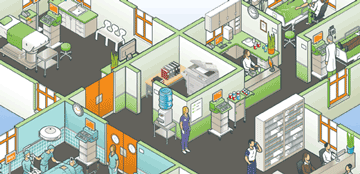
Top 6 FAQs when Choosing Healthcare Power Products
Selecting compliant power products is an essential but often confusing part of a healthcare manager’s job. If you purchase power strips, surge protectors, isolation transformers or uninterruptible power supplies for your facility, the following questions and answers will help you make an informed choice.

1. How does location affect my choice of power products?
Where you install your power products can determine the type of product you need to purchase. From a regulatory standpoint, there are two distinct areas within healthcare facilities: inside the patient care area and outside the patient care area. If a power product is installed inside a patient care area, it must be “medical-grade” and UL 60601-1 compliant.
2. How is a “patient care area” defined?
A patient care area is “any area within a healthcare facility where patients are intended to be examined or treated.” Patient care areas include both general- and critical-care areas:
- General Care Areas—patient bedrooms, examining rooms, treatment rooms, clinics and similar areas where patients come in contact with “ordinary devices” such as nurse call systems, electrical beds, examining lamps, telephone or entertainment devices and electro-medical equipment.
- Critical Care Areas—special care units such as intensive care units, delivery rooms, operating rooms, coronary care units, angiography labs and other areas where patients will be subjected to invasive procedures and connected to on-line electro-medical devices.
3. How is “patient care vicinity” defined?
A patient care vicinity is “a space within a location intended for the examination and treatment of patients (i.e., patient care area) extending 6 ft. beyond the normal location of the bed, chair, table, treadmill, or other device that supports the patient during examination and treatment and extends vertically 7 ft. 6 in. above the floor.”
4. What is the difference between “medical-grade” and “hospital-grade”?
These terms are often used synonymously. “Medical-Grade” power products are UL 60601-1 compliant and designed for use inside the patient care vicinity. They are not to be confused with power products that feature a “Hospital-Grade” plug and/or receptacles.
Many healthcare facilities unknowingly install non-compliant power strips, surge protectors and backup power supplies in patient care areas, believing that all models with hospital-grade plugs and receptacles are UL 60601-1 compliant. They are not. The use of non-compliant products can be dangerous and should be immediately replaced by fully-compliant models.
5. What is the difference between “UL-Listed” and “UL-Recognized”?
Two power strips can meet the requirements of the same UL standard (60601-1, for example) but receive two different UL ratings: either “listed” or “recognized.” The difference is simple: UL “lists” a stand-alone product, but “recognizes” a product that is a component of a larger system. In healthcare applications, power strips that stand alone and are not designed as components of a larger system are UL-listed.
6. What standards apply to mobile applications?
Some diagnostic, treatment, or monitoring equipment can be moved in and out of the patient care vicinity and is therefore subject to the UL 60601-1 standard. Specialty purpose power strips and backup power supplies are available as components of larger medical systems. These products are UL-recognized for 60601-1 and 1363a standards and can be used both inside and outside of patient care areas.
- UL 60601-1: patient shock-prevention measure required for all devices that potentially come in contact with patients and staff.
- UL 1363a: standard for power strips that are integrated as components of a larger system, where they supply power to equipment in movable assembly that is rack- table- or pedestal-mounted.
Request a Complimentary Consultation
Please fill out the form below.
*Required Fields.
Tripp Lite will never sell, rent or share your information. View Privacy Policy.
